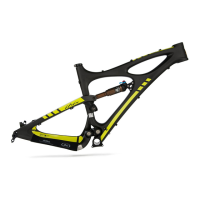32
Tuning the RC4
There is a wide range of adjustment
on the RC4 and you can control
damper movement very precisely.
Make the adjustments in this order–
and make only one change at a time
so you know how each adjustment
affects ride.
1) Check sag and make sure the spring
rate is correct first. If you can’t get
sag in the ballpark within 1-2 turns
of preload you’ll need a different
spring rate.
2) Set rebound to personal preference.
We always go as fast as possible
without getting bucked.
3) At first, leave Boost Valve pressure
where it comes from the factory–
160psi. We’ve found 160psi works
great on most bikes so don’t touch
this adjustment until you’ve had a
chance to ride first. On DHX RC
shocks, BV pressure only controls
the last 1/3 of the stroke. Chang-
ing BV pressure will not affect your
pedaling feel or mid stroke feel–
only deep stroke & bottom out.
4) Set the low speed compression
adjuster to control pedaling & corner-
ing feel. This is personal preference,
but it’s probably good to start in the
middle. There are normally 18-20
detents of adjustment here so start
halfway… 9 clicks out from full
closed. If you find that’s too harsh on
the small stuff then back off another
halfway… 4-5 clicks to make a notice-
able difference. Conversely if you feel
the bike is wallowing or too mushy,
or geometry is changing too much in
the corners you can firm it up 4 clicks.
The key is to make each adjustment
about half of what the last adjust-
ment was, continually narrowing
down the range until you arrive at the
best setting. This technique is called
bracketing and can be used on all
shock tuning adjustments in turn to get
a very precise setup.
5) Set the high speed compression
adjuster (a 2.5m hex key fits in the
holes) to control feel on big spiky hits
and square-edged bumps. Again this
is personal preference and can be
tuned by bracketing. Faster, aggres-
sive riders or courses with really big
hits require more HSC damping to
keep from using excessive travel and
rebounding harshly. There are around
12 detents of adjustment here so start
in the middle at 6. If it’s too harsh
then back off 3. Too soft, increase by
3. Then narrow your changes to 1-2
clicks each time.
6) Once you have high & low speed
dialed, use the bottom out volume
adjuster (blue cylinder on the end of
the reservoir) to increase or decrease
bottom out resistance. Turning the
adjuster in – clockwise – increases
bottom out resistance and vice-
versa. Again, start in the middle and
bracket. If you’re bottoming too hard
turn the adjuster all the way in and
re-test. If that’s too much and prevents
full travel go halfway. If you then find
halfway is too soft then go halfway
between half and full in, etc.
7) If you find you’re still bottoming too
hard with the volume adjuster all the
Rear Shock Set-Up

